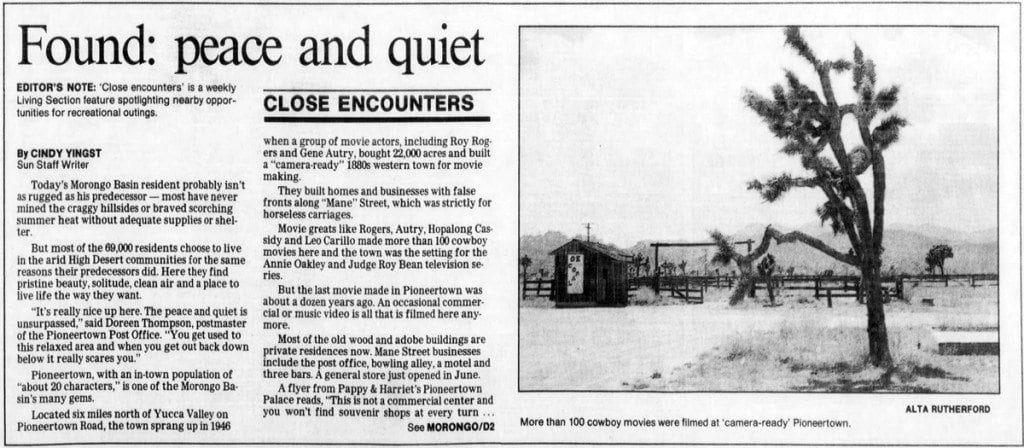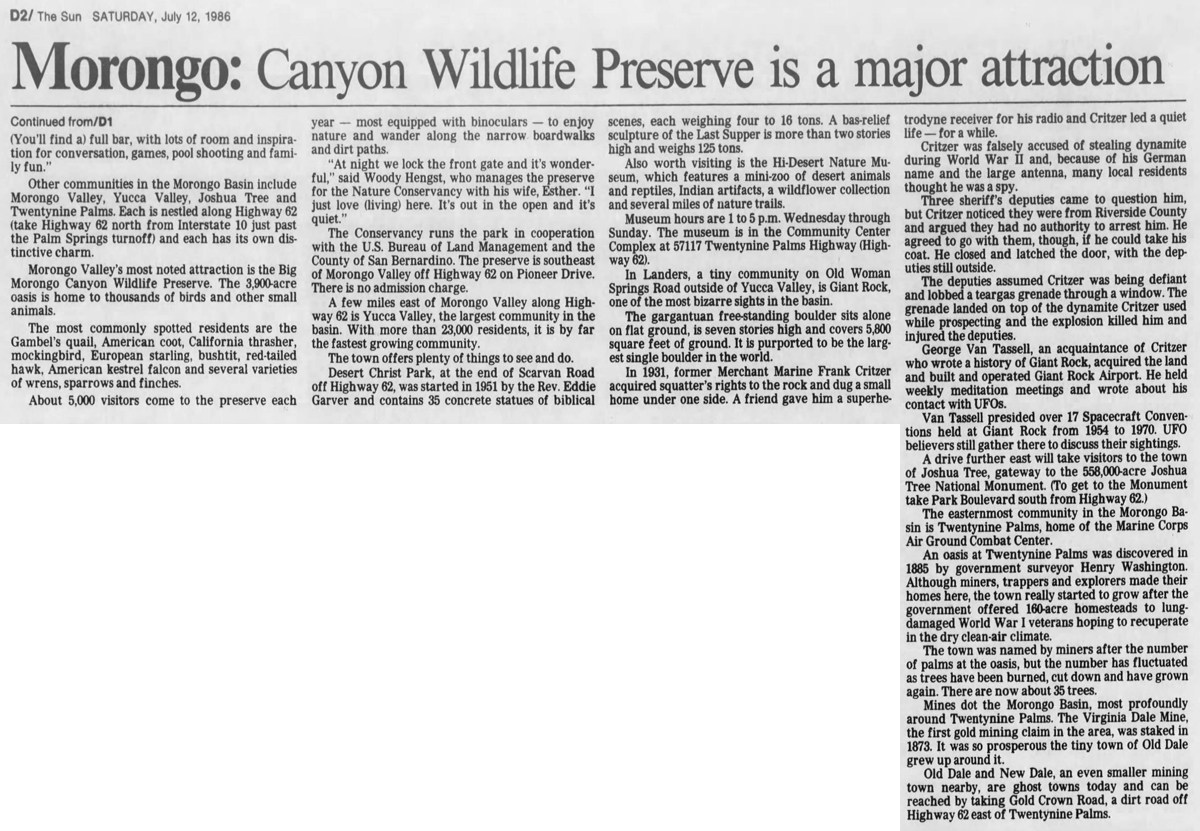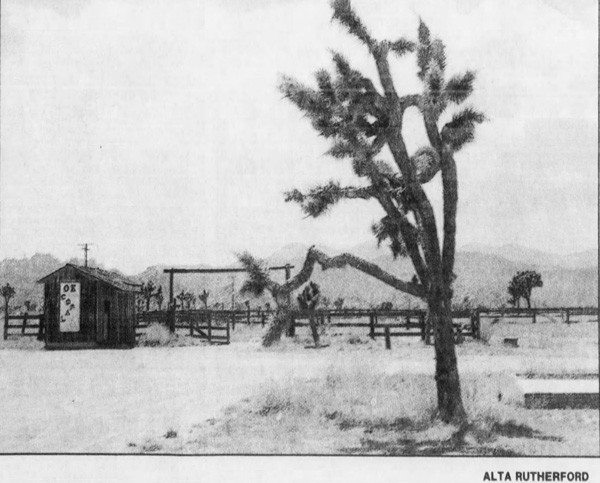Found: peace and quiet
CLOSE ENCOUNTERS EDITOR’S NOTE; ‘Close encounters’ is a weekly Living Section feature spotlighting nearby opportunities for recreational outings.
By CINDY YINGST
SUN STAFF WRITER
Today’s Morongo Basin resident probably isn’t as rugged as his predecessor — most have never mined the craggy hillsides or braved scorching summer heat without adequate supplies or shelter.
But most of the 69,000 residents choose to live in the arid High Desert communities for the same reasons their predecessors did. Here they find pristine beauty, solitude, clean air and a place to live life the way they want.
“It’s really nice up here. The peace and quiet is unsurpassed,” said Doreen Thompson, postmaster of Pioneertown Post Office. “You get used to this relaxed area and when you get out back down below it really scares you.”
Pioneertown, with an in-town population of “about 20 characters,” is one of the Morongo Basin’s many gems.
Located six miles north of Yucca Valley on Pioneertown Road, the town sprang up in 1946 when a group of movie actors, including Roy Rogers and Gene Autry, bought 22,000 acres and built a “camera-ready” 1880’s western town for movie making.
They built homes and businesses with false fronts along “Mane” Street, which was strictly for horseless carriages.
Movie greats like Rogers, Autry, Hopalong Cassidy and Leo Carillo made more than 100 cowboy movies here and the town was the setting for the Annie Oakley and Judge Roy Bean television series.
But the last movie made in Pioneertown was about a dozen years ago. An occasional commercial or music video is all that is filmed here anymore.
Most of the old wood and adobe buildings are private residences now. Mane Street businesses include the post office, bowling alley, a motel and three bars. A general store just opened in June.
A flyer from Pappy & Harriet’s Pioneertown Palace reads, “This is not a commercial center and you won’t find souvenir shops at every turn…
Continued on / D2
Morongo: Canyon Wildlife Preserve is a major attraction
Continued from /D1
(You’ll find a) full bar, with lots of room and inspiration for your conversation, games, pool shooting and family fun.”
Other communities in the Morongo Basin include Morongo Valley, Yucca Valley, Joshua Tree and Twentynine Palms. Each is nestled along Highway 62 (take Highway 62 turnoff) and each has its own charm.
Morongo Valley’s most noted attraction is the Big Morongo Canyon Wildlife Preserve. The 3,900-acre oasis is home to thousands of birds and other small animals.
The most commonly spotted residents are the Gambel’s quail, American coot, California thrasher, mockingbird, European starling, bushtit, red-tailed hawk, American kestrel falcon and several varieties of wrens, sparrows, and finches.
About 5,000 visitors come to the preserve each year — most equipped with binoculars — to enjoy nature and wander along the narrow boardwalks and dirt paths.
“At night we lock the front gate and it’s wonderful,” said Woody Hengst , who manages the preserve from the Nature Conservancy with his wife, Esther. “I just love (living) here. It’s out in the open and it’s quiet.”
The Conservancy runs the park in cooperation with the U.S. Bureau of Land Management and the County of San Bernadino. The preserve is southeast of Morongo Valley off Highway 62 on Pioneer Drive. There is no admission charge.
A few miles east of Morongo Valley along Highway 62 in Yucca Valley, the largest community in the basin. With more than 23,000 residents, it is by far the fastest growing community.
The town offers plenty of things to see and do.
Desert Christ Park, at the end of Scarvan Road off Highway 62, was started in 1951 by the Rev. Eddie Garver and contains 35 concrete statues of biblical scenes, each weighing four to 16 tons. A bas-relief sculpture of the Last Supper is more than two stories high and weighs 125 tons.
Also worth visiting is the Hi-Desert Nature Museum, which features a mini-zoo of desert animals and reptiles, Indian artifacts, a wildflower collection and several miles of nature trails.
Museum hours are 1 to 5 p.m. Wednesday through Sunday. The museum is in the Community Center Complex at 57117 Twentynine Palms Highway (Highway 62).
In Landers, a tiny community on Old Woman Springs Road outside of Yucca Valley, is Giant Rock, one of the most bizarre sights in the basin.
The gargantuan free-standing boulder sits alone on flat ground, is seven stories high and covers 5,800 square feet of ground. It is purported to be the largest single boulder in the world.
In 1931, former Merchant Marine Frank Critzer acquired squatter’s rights to the rock and dug a small home under one side. A friend gave him a superhetrodyne receiver for his radio and Critzer led a quiet life — for a while.
Critzer was falsely accused of stealing dynamite during World War II and, because of his German name and the large antenna, many local residents thought he was a spy.
Three sheriff’s deputies came to question him, but Critzer noticed they were from Riverside County and argued they had no authority to arrest him. He agreed to go with them, though, if he could take his coat. He closed and latched the door, with the deputies still outside.
The deputies assumed Critzer was being defiant and lobbed a teargas grenade through a window. The grenade landed on top of the dynamite Critzer used while prospecting and the explosion killed him and injured the deputies.
George Van Tassell, an acquaintance of Critzer who wrote a history of Giant Rock, acquired the land and built and operated Giant Rock Airport. He held weekly
He held weekly meditation meetings and wrote about his contact with UFOs.
Van Tassell presided over 17 Spacecraft Conventions held at Giant Rock from 1954 to 1970. UFO believers still gather there to discuss their sightings.
A drive further east will take visitors to the town of Joshua Tree, gateway to the 558,00-acre Joshua Tree National Monument. (To get to the Monument take Park Boulevard south from Highway 62.)
The easternmost community in the Morongo Basin is Twentynine Palms, home of the Marine Corps Air Ground Combat Center.
An oasis at Twentynine Palms was discovered in 1885 by government surveyor Henry Washington. Although miners, trappers and explorers made their homes here, the town really started to grow after the government offered 160-acre homesteads to lung-damaged World War I veterans hoping to recuperate in the dry clean-air climate.
The town was named by miners after the number of palms at the oasis, but the number has fluctuated as trees have been burned, cut down and have grown again. There are now about 35 trees.
Mines dot the Morongo Basin, most profoundly around Twentynine Palms. The Virginia Dale Mine, the first gold mining claim in the area, was staked in 1873. It was so prosperous the tiny town of Old Dale grew up around it.
Old Dale and New Dale, an even smaller mining town nearby, are ghost towns today and can be reached by taking Gold Crown Road, a dirt road off Highway 62 east of Twentynine Palms.



